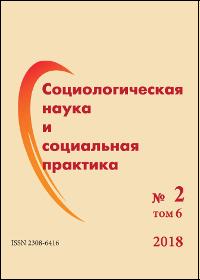Факторы доходной стратификации российского общества: роль структурных барьеров на пути восходящей доходной мобильности. Часть 2
Аннотация
Литература
Каравай А. В. Состояние и динамика качества человеческого капитала российских рабочих // TERRA ECONOMICUS. 2017. № 3. С. 144–158.
Козырева П. М. Ресурсы и практики социально-экономической адаптации населения России. М.: Новый хронограф, 2013. 328 с.
Лежнина Ю. П. Социально-демографические факторы, определяющие риск бедности и малообеспеченности // Социологические исследования. 2010. № 3. С. 36–45.
Лежнина Ю. П. Семья для среднедоходных слоёв населения: тыл или риск? // Журнал исследований социальной политики. 2017. Т. 15. № 3. С. 435–452.
Логинов Д. М., Авраамова Е. М. Социально-экономическая адаптация: ресурсы и возможности // Общественные науки и современность. 2002. № 5. С. 24–34.
Марно В. Модели с множественным откликом // Путеводитель по современной эконометрике / Пер. с англ. В. А. Банникова; науч. ред. и предисл. С. А. Айвазяна. М.: Научная книга, 2008. С. 316–329.
Овчарова Л. Н. Теоретические и практические подходы к оценке уровня, профиля и факторов бедности: российский и международный опыт. М.: М-Студио, 2009. 268 с.
Овчарова Л. Н., Попова Д. О., Рудберг А. М. Декомпозиция факторов неравенства доходов в современной России // Журнал новой экономической ассоциации. 2016. № 3 (31). С. 170–186.
Радаев В. В. Понятие капитала, формы капиталов и их конвертация // Экономическая социология. 2002. Т. 3. № 4. С. 20–32.
Россия в цифрах. 2016: крат. стат. сб. / Росстат-M., 2016. 543 с. [Электронный ресурс] // URL: http://www.gks.ru/free_doc/doc_2016/rusfig/rus16.pdf (дата обращения: 16.11.2017).
Сивуха С. В., Титма М. Х. Социальные детерминанты самооценки успеха // Социальное расслоение возрастной когорты / Под общ. ред. М. Х. Титмы. М.: Ин-т социологии РАН, 1997. С. 250–274.
Слободенюк Е. Д. Факторы абсолютной и субъективной бедности в современной России // Вестник общественного мнения. Данные. Анализ. Дискуссии. 2016. № 3–4. С. 82–92.
Слободенюк Е. Д. Последствия кризиса 2015 г.: обеднение или прекаризация? // Журнал исследований социальной политики. 2017. № 2. С. 183–200.
Терещенко О. В. Многомерный статистический анализ данных в социальных науках: учеб. пособие / О. В. Терещенко, Н. В. Курилович, Е. И. Князева. Минск: БГУ, 2012. 239 с.
Терещенко О. В., Титма М. Х. Дифференциация доходов в когорте тридцатилетних // Социологический журнал. 1996. № 3–4. С. 196–217.
Тихонова Н. Е. Социальная структура России: теории и реальность. М.: Новый хронограф; Ин‑т социологии РАН, 2014. 408 с.
Тихонова Н. Е. Стратификация по доходу в России: специфика модели и вектор изменений // Общественные науки и современность. 2017. № 2. С. 23–35.
Тихонова Н. Е., Каравай А. В. Человеческий капитал российских рабочих: общее состояние и специфические особенности // Мир России. 2017. № 3. С. 6–35.
Хахулина Л. А., Тучек М. Распределение доходов: бедные и богатые в постсоциалистических обществах (некоторые результаты сравнительного анализа) // Мониторинг общественного мнения: экономические и социальные перемены. 1995. № 1. С. 18–22.
Anikin V.A., Lezhnina Y.P., Mareeva S.V., Slobodenyuk E.D., Tikhonovа N.Е. Income stratification: Key approaches and their application to Russia // Higher School of Economics Research Paper No. WP BRP 02/PSP/2016. Moscow: National Research University Higher School of Economics, 2016.
Bourdieu P., Passeron J. C. Reproduction in education, society and culture. London: Sage, 1990. Vol. 4.








 Издатель: Федеральное государственное бюджетное учреждение науки
Издатель: Федеральное государственное бюджетное учреждение науки